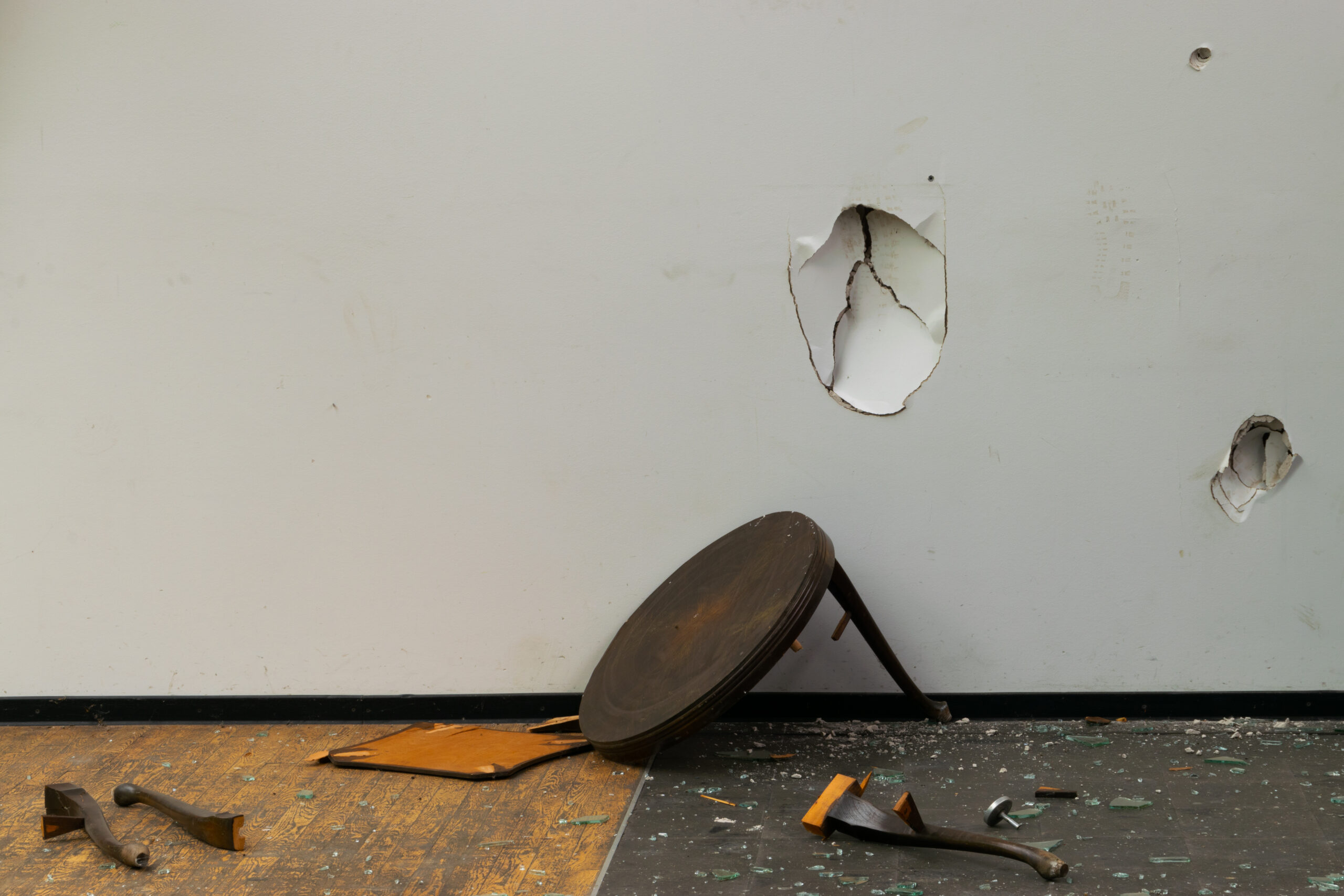Shlomo Hamelech (Koheles) famously tells us that “there is nothing new under the sun.” Meforshim point out that it is only under the sun, meaning in our physical world, that there is nothing new. However, in the world of Torah, there are always chiddushim, new and amazing ideas arising. Thus, “ain bais hamedrash bli chiddush – each house of torah study inevitably creates new ideas and interpretations.” Therefore, whenever we hear of some contemporary phenomenon which seems original, we must look again with a Torah eye.
I live on Long Island, so this may be unique to my local oddities, but I doubt it. What is now “all the rage”? The answer is actually a place called the “Rage Room.”
What does one do in a Rage Room? The answer is painfully obvious. One goes to get rid of one’s rage and anger. How? Again, six people at a time can let out their anger at inanimate objectionable objects such as TVs, microwaves, printers, computers, garden gnomes and – yes – smartphones. Don’t worry about getting hurt. You will be handed a “full-body hazmat suit, a pair of yellow and black protective gloves and a motorcycle-like helmet with anti-fog goggles and mouth guard.” Of course, some of our dear readers will be sure that I am still (somewhat) ad d’lo yoda and am seeking to extend the Purim spirit. But, alas, this article was published recently in Newsday, the Long Island newspaper (February 28, 2023, page B2). The weapons of choice range from a sledgehammer to a baseball bat, golf club or pipe wrench. The alleged purpose? To “blow off steam in a controlled setting.”
Is this good or bad, positive or literally destructive? Let’s listen to what the Torah says and even discover a surprising connection to Parshas Parah.
First of all, it certainly seems that there are a lot of angry people out there. Anger management classes are full and criminologists, psychologists and therapists of all stripes also have their hands full dealing with the results. The Torah seems to have a dual response to “letting out our anger.” On the one hand, Chazal (Shabbos 105b) teach that one who breaks vessels in his anger is viewed as having worshipped idols. On the other hand, the Rambam (Hilchos Shabbos 8:8) rules that although generally one is not liable for transgressing the Shabbos prohibitions by breaking something, if he is assuaging his anger, this is considered to be a positive act and he is liable for some melacha. Now, to be sure, the Raavad disagrees and does not consider this to be a completely positive action. Nevertheless, if Shabbos were not the issue, we could perhaps imagine the Rambam sanctioning such a catharsis if it results in calming someone’s baser instincts. The Rambam later on (ibid. 12:1) even considers this breakage to have positive repercussions if it helps our hazmat wearer purge his need for revenge against his enemy.
This conundrum is raised by the Kaliver Rebbe, Rav Menachem Mendel Taub (Kol Menachem, Parshas Chukas, page 237), in discussing Moshe Rabbeinu. He raises the issue of how Moshe Rabbeinu could have lost his temper and broken the luchos. The rebbe even suggests that for Moshe Rabbeinu, the parah adumah was indeed the proverbial purifier of the defiled and defiler of the pure. He explains that Moshe Rabbeinu was moser nefesh – he risked his soul – for us by allowing himself to become so enraged. In other words, in Moshe’s case, his anger, which eventually helped Klal Yisroel to be forgiven, resulted in a positive purpose. Of course, that would mean that although the Torah does use the term “anger” for Moshe Rabbeinu, it was in a controlled form, targeting a particular positive result. Hence, we might discover some miniscule or even microcosm of approval for the Long Island Rage Room. The Kaliver Rebbe (page 236) also adds that in the case of the parah adumah and the copper serpent, Moshe Rabbeinu utilized them both as a teaching moment to illustrate to all of us that although we cannot always understand how, Hashem’s presence is everywhere and we can use many venues to achieve healing and purification. He also points out that these methods can also become harmful and dangerous in the wrong hands.
If I may be so bold and add with trepidation, the ultimate source of this concept might be from the Creator Himself. We know that if Moshe Rabbeinu had built the Mishkon, it and the Bais Hamikdosh itself could never have been destroyed. The negative aspect of that seeming boon was that Hashem could not have “let out his wrath on the sticks and stones,” but upon His people alone, and we cannot even imagine what level of destruction would have been the result. Thus, although, of course, Hashem has no needs and no emotions whatsoever, He taught us that as long as we have not lost control, directed anger can have salubrious effects. Although obviously we cannot jump to any conclusions from the actions of the Creator for our own benefit, still, Chazal teach as one of the primary rules of life that we should seek to emulate our Father in Heaven.
All this being said and Rage Rooms aside, the Torah teaches that there is a much better way. Even if a person temporarily “lets out his anger,” he will probably still be subject to tantrums and explosions. Chazal (Pesochim 113b) teach that one who loses his temper easily really has no life. He has no control over himself and is constantly debasing himself in front of his loved ones and others. He grows old rapidly because he uses up his lifeblood on unimportant and trivial things (Tanchuma, Chayei Sarah 2). Such a person doesn’t live in a real world, but in a gehennom of constant anger and disappointment (Nedorim 22a).
So if not the Rage Room, what should a generically anger-challenged person do? First of all, rabbonim and frum therapists can suggest books and methods for achieving happiness in life, despite some personal challenges. The month of Adar and the post-Purim time are the best opportunity for this kind of study. As Chazal point out, Adar remains a totally happy month, although we still live in Achashveirosh’s world. At the end of the Megillah, Klal Yisroel lives in a world of light and joy because we have learned to cope with the evil Achashveiroshes of the world. From now on, even if we have to attend their parties, we will not be happy to be there. We will (finally) take off our masks and be happy to be who we are.
Secondly, Rav Zalman Sorotzkin points that even Moshe Rabbeinu learned a lesson from his spontaneous reaction to the sin of the Eigel. Later, when he is dissatisfied with something the Jewish soldiers did, he keeps his reaction to himself and later speaks to them softly (Oznayim LaTorah, Parshas Matos). Not every situation requires an immediate response. The Chida teaches that a teacher should not lose his temper even if it is justified, since in any case anger is a bad middah and will just cause more of it to be disseminated (Rav Pe’alim to Brachos 28a). In case we would think that one cannot change without throwing things at a convenient wall, we should remember that Rav Nachman of Breslov used to say that he once had a terrible temper, which he conquered and literally converted into a loving disposition to all, even those who viciously opposed him.
Rav Yisroel Salanter, the role model for the last century and more for interpersonal relations, taught a simple antidote to rage. It is to become a person of chesed. Rav Eliyahu Eliezer Dessler teaches in Michtav M’Eliyahu that chesed not only helps the recipient, but vastly improves the one extending the kindness. This is because once a person invests in others – time, love, sometimes money – he cares about them because they have grown into one. All of a sudden, all anger and irritation disappear because a person has higher goals and aspirations than the pettiness of those constantly angry and disappointed in people and life itself.
Even – and especially! – our greatest constantly worked on their middos throughout life. One of the Chofetz Chaim’s talmidim saw him lying on the floor and became very alarmed. The Chofetz Chaim calmed the young boy down, explaining that he had caught himself almost becoming angry about something and he was literally expelling the bad moment out. When Rav Yitzchok Blazer moved to Eretz Yisroel, he was planning to retire and sit and learn. However, his sterling demeanor and self-control were so contagious that he soon developed a following, seeking to emulate his inner calm and absolute iron control over any anger or displeasure.
No, we don’t have to throw things at a wall, but we can work on ourselves so that we have nothing to be angry about, as we are still going from the joy of Purim to the joy of Pesach without descending into any negatives requiring violence at all.








